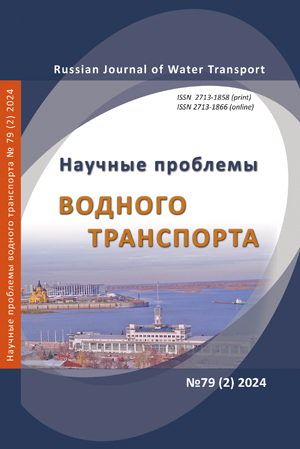Specifics of application of natural stiffening elements in ship structures made of composite materials
Abstract
The article discusses a range of issues related to the design of ship structures made of composite materials. To form the surface of such structures, natural stiffness elements are often used, which determine the shape and functionality of the product, and at the same time ensure its strength and rigidity. These include angles, corrugations, curvature and similar elements, which are analyzed in the article by serial calculations using finite element methods and batch analysis of laminates. The factors of reducing the weight of structures due to stiffness elements are highlighted. A review of the normative methods of accounting for these elements in different rules has been carried out and recommendations for their implementation in domestic regulatory documents have been given. The necessity of a fundamentally different approach to the design of structures made of composite materials is emphasized.
References
ISO-12215 - 5:2008 Small craft - Hull construction and scantlings - Part 5 design pressures, design stresses, scantling determination.
ISO-12215 - 5:2019 Small craft - Hull construction and scantlings - Part 5 design pressures, design stresses, scantling determination.
Rules for Classification of High Speed and Light Craft. DNV– 2023.
ABS Rules for Building and Classing High-Speed Craft (HSC Rules), 2023.
Rules for Classification and Construction of High Speed Craft. German Lloyd, 2012.
Turk Loydu Rules – Chapter 7 - High Speed Crafts – July 2023. Turkish Lloyd.
Rules and Regulations for the Construction and Classification of High Speed and Light Craft. IRS, 2021.
Rules for the classification of High Speed and Light Crafts – Korean Register, 2023 -KR.
Guidelines for Commercial Craft. VTT. Version 2016-2.
Правила классификации и постройки морских судов. Часть XVI. Конструкция и прочность судов из полимерных композиционных материалов. Российский морской регистр судоходства, 2023.
Королев С.А., Назаров А.Г. Автоматизация расчетов прочности судовых конструкций из композиционных материалов// «Судостроение» №2-2023 (867), с.23-29.
Правила классификации и постройки судов. Российский Речной Регистр, 2019.
Корпуса и корпусные конструкции из стеклопластика. Правила проектирования и методические указания по расчетам прочности. РД5.1186-90.
Nazarov A. Composite High Speed Craft: Practical Design Approaches// 4nd Chesapeake Power Boat Symposium - Annapolis, USA, 2014.
Францев М.Э. Дефектоскопия корпусов судов из композиционных материалов, находящихся в эксплуатации, акустическими методами неразрушающего контроля. — Дефектоскопия. 2013. №1. С. 3–11.
Marine Composites. Design and Performance. Edited by Pemberton R., Woodhead Publishing, 2019.
Copyright (c) 2024 Russian Journal of Water Transport

This work is licensed under a Creative Commons Attribution 4.0 International License.













